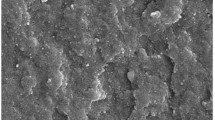Conclusions
It has been shown that the conclusion of the Van Oene theory that the polymer with the greater melt elasticity should form a disperse type of structure and the polymer with the lower elasticity should form a stratified (laminar) structure is not fulfilled for polyoxymethylene-ethylene-propylene copolymer mixtures at ratios of 80:20 and 20:80. This means that at low content of the disperse phase polymer a disperse morphology is the most typical, regardless of the degree of elasticity of the melt.
It has been found that an elevated elasticity of the disperse phase polymer does not aid “specific fibre-formation.”
A disperse state of the polymer in a mixture and the formation of an interfacial layer lead to a decrease in the temperature (by tens of degrees) and heat effect (several-fold) of phase transitions.
The interconnection between structure-formation processes and the rheological properties of the polymer mixture melt is manifested in a decrease in viscosity, an intensification of the viscosity anomaly, and an increase in the elasticity of the melt mixture as compared with these same characteristics of the starting polymers.
Similar content being viewed by others
Literature cited
L. B. Kandyrin, Author's Abstract of Candidate's Dissertation. M. V. Lomonosov MITKhT, Moscow (1971).
M. V. Tsebrenko, A. V. Yudin, et al., Vysokomol. Soed., Ser. B,15, No. 8, 566–567 (1973).
M. V. Tsebrenko, Int. J. Polymetric Mater., No. 10, 83–119 (1983).
M. V. Tsebrenko, T. I. Ablazova, et al., Vysokomol. Soed., Ser. A,18, No. 2, 420–425 (1976).
Van Oene, J. Coll. Interf. Sci.,40, No. 3, 448–467 (1972).
M. V. Tsebrenko, N. M. Rezanova, and A. V. Yudin, Khim. Volokna, No. 6, 36–38 (1976).
D. F. Dement'ev, M. A. Zhdanov, and A. N. Kirsanov, Application of Mathematical Statistics in Petroleum-Gas Industry Geology [in Russian], Nedra, Moscow (1977).
H. B. Chin and C. D. Han, J. Rheol.,23, No. 5, 557–590 (1979).
M. V. Tsebrenko, N. M. Rezanova, and I. N. Syplivets, Vysokomol. Soed., Ser. A,27, No. 7, 544–550 (1985).
M. V. Tsebrenko, Khim. Volokna, No. 5, 33–34 (1980).
Additional information
Translated from Khimicheskie Volokna, No. 3, pp. 8–10, May–June, 1988.
Rights and permissions
About this article
Cite this article
Tsebrenko, M.V., Benzar, A.I., Sizevich, T.I. et al. Rheological properties of melts and structure formation in polyoxymethylene-ethylene-propylene copolymer mixtures. Fibre Chem 20, 160–163 (1989). https://doi.org/10.1007/BF00633043
Received:
Issue Date:
DOI: https://doi.org/10.1007/BF00633043



